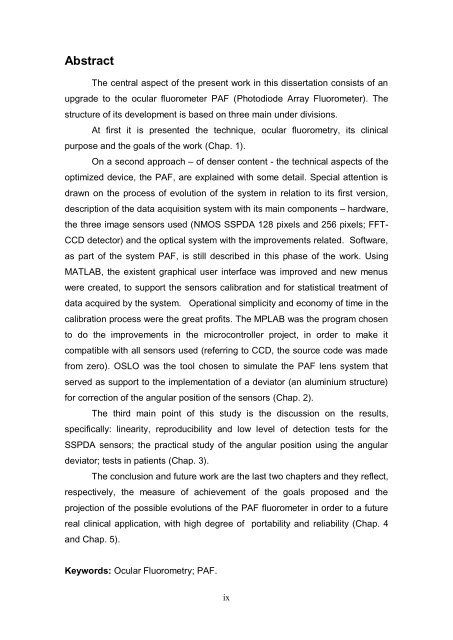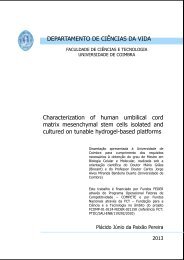Manuel Francisco da Costa Vitor - Estudo Geral - Universidade de ...
Manuel Francisco da Costa Vitor - Estudo Geral - Universidade de ...
Manuel Francisco da Costa Vitor - Estudo Geral - Universidade de ...
Create successful ePaper yourself
Turn your PDF publications into a flip-book with our unique Google optimized e-Paper software.
Abstract<br />
The central aspect of the present work in this dissertation consists of an<br />
upgra<strong>de</strong> to the ocular fluorometer PAF (Photodio<strong>de</strong> Array Fluorometer). The<br />
structure of its <strong>de</strong>velopment is based on three main un<strong>de</strong>r divisions.<br />
At first it is presented the technique, ocular fluorometry, its clinical<br />
purpose and the goals of the work (Chap. 1).<br />
On a second approach – of <strong>de</strong>nser content - the technical aspects of the<br />
optimized <strong>de</strong>vice, the PAF, are explained with some <strong>de</strong>tail. Special attention is<br />
drawn on the process of evolution of the system in relation to its first version,<br />
<strong>de</strong>scription of the <strong>da</strong>ta acquisition system with its main components – hardware,<br />
the three image sensors used (NMOS SSPDA 128 pixels and 256 pixels; FFT-<br />
CCD <strong>de</strong>tector) and the optical system with the improvements related. Software,<br />
as part of the system PAF, is still <strong>de</strong>scribed in this phase of the work. Using<br />
MATLAB, the existent graphical user interface was improved and new menus<br />
were created, to support the sensors calibration and for statistical treatment of<br />
<strong>da</strong>ta acquired by the system. Operational simplicity and economy of time in the<br />
calibration process were the great profits. The MPLAB was the program chosen<br />
to do the improvements in the microcontroller project, in or<strong>de</strong>r to make it<br />
compatible with all sensors used (referring to CCD, the source co<strong>de</strong> was ma<strong>de</strong><br />
from zero). OSLO was the tool chosen to simulate the PAF lens system that<br />
served as support to the implementation of a <strong>de</strong>viator (an aluminium structure)<br />
for correction of the angular position of the sensors (Chap. 2).<br />
The third main point of this study is the discussion on the results,<br />
specifically: linearity, reproducibility and low level of <strong>de</strong>tection tests for the<br />
SSPDA sensors; the practical study of the angular position using the angular<br />
<strong>de</strong>viator; tests in patients (Chap. 3).<br />
The conclusion and future work are the last two chapters and they reflect,<br />
respectively, the measure of achievement of the goals proposed and the<br />
projection of the possible evolutions of the PAF fluorometer in or<strong>de</strong>r to a future<br />
real clinical application, with high <strong>de</strong>gree of portability and reliability (Chap. 4<br />
and Chap. 5).<br />
Keywords: Ocular Fluorometry; PAF.<br />
ix

















